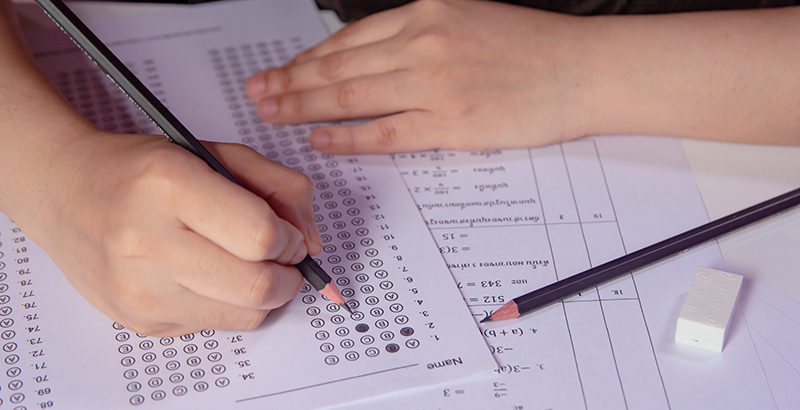Analysis: Nearly One-Quarter of States Are Leaving the Public in the Dark About 2021’s Standardized Tests. That’s a Huge Problem

Get stories like this delivered straight to your inbox. Sign up for The 74 Newsletter
Get essential education news and commentary delivered straight to your inbox. Sign up here for The 74’s daily newsletter.
Correction appended Jan. 12
We knew the picture of student learning during the COVID-19 pandemic would be murky, as states canceled standardized testing in 2020 and the federal government relaxed rules on how testing should work in 2021.
This year, parents and policymakers will have a lot more clarity in some states than others. Our nationwide review of state testing policies finds that some states managed to pull off standardized testing in 2021 with the same levels of student participation they could expect in a normal year and reported the results publicly — with all the caveats that come with testing during a global pandemic, when many students were still learning remotely.
But nearly one-quarter of states are leaving the public in the dark, reporting no information at all about how many students took the tests or what results look like.
The Center on Reinventing Public Education examined plans for reporting assessment results in every state. As of late November, 38 states shared information about their end-of-year test results from the 2020-21 school year on their webpage. Twelve states and Washington, D.C., have been silent on the topic.
Of the states that did report assessment results, plans for making the data public and reporting results in ways that will be meaningful to parents or policymakers varied widely. As a result, the amount of clarity state policymakers have going into crucial spring legislative sessions is all over the map. And so is the information parents have about how their children fared on standardized tests they took this spring.
Participation is low and inconsistently reported
One critical data point for interpreting state test results is the percentage of students who actually take the tests. This year, the U.S. Department of Education relaxed the usual expectation that at least 95 percent of students in applicable grades participate in the end-of-year exams. With no need to ensure they were meeting the federal requirement, states reported participation rates in a variety of formats that aren’t always possible to compare.
- 20 states reported statewide participation for all students
- 3 states reported ranges across school districts or schools within a state
- 10 states reported by tested subject area (e.g., math)
- 1 state reported by grade or grade band (e.g., middle school)
There was some overlap among those groups, while 19 states reported no participation information at all. Of the 20 states that reported statewide participation for all students, the rates ranged from 10 percent in New Mexico to 97.5 percent in Louisiana. Eight states — Arkansas, Florida, Indiana, Louisiana, Massachusetts, Mississippi, North Dakota and Wyoming — reported meeting or exceeding the typical 95 percent threshold overall or in a single subject area.
In the remaining 42 states, policymakers will have to tread carefully in interpreting state test results, because large numbers of students likely don’t show up. Research suggests the missing students may also be the ones who suffered the most negative academic impact during the pandemic.
Some states adapted testing windows and reporting strategies
In February, the department recommended that states consider offering tests in the summer or even fall to increase participation rates. However, only three states shifted their end-of-year tests to the fall: New Jersey, Pennsylvania and Washington.
While these states may wind up with higher participation than if they had administered exams in the spring, shifting the dates may pose other challenges. For instance, some educators are concerned that fall assessments could paint an even more negative picture of student performance than ordinary spring tests because usual summer learning losses will add to the already-serious negative academic impact of the pandemic. In addition, the fall results will not be available until January 2022 at the earliest, meaning educators will be more than halfway through the school year before they get standardized test results from the previous year.
The Nebraska Department of Education has assessment results but will not be reporting them publicly. The state is overhauling its assessments, replacing a single end-of-year test with a series of exams students will take throughout the year. The state offered a shorter test this year that it says took less time away from instruction and will aid in the transition to the new assessment regime. The department says the results from the revamped tests administered in 2021 will not be comparable to previous years’, will not be reported publicly and will not be shared with families.
Some state leaders have rightly urged caution when interpreting spring 2021 test results, but experts have outlined steps states can take to make their results as meaningful as possible. For example, the Center for Assessment suggests analysts should account for missing data due to decreased participation rates, and Harvard University’s Andrew Ho provides three test-score metrics that are necessary to produce meaningful comparisons despite missing data from 2020 and flawed data from 2021.
In addition, researchers have helped states like Ohio and Indiana interpret 2021 assessment data — and, worryingly, their results have shown that the students missing in the data may be the ones who need the most support.
It’s no wonder civil rights and data advocacy organizations are calling on all states to publicly report their spring 2021 assessment data and engage in the difficult conversations about what they mean for rebuilding and recovery across communities.
Rethinking assessments in 2022 and beyond
Thinking ahead to spring 2022, it will be critical for state and district leaders to get a meaningful picture of their students’ academic needs.
Schools and districts offer interim assessments that help local leaders make sense of the magnitude of unfinished learning by school and by student, but data from end-of-year tests can provide a high-level view of systemic inequities that can inform states’ decisions about how to spend money and where to target improvement efforts. Spring 2022 is a prime moment for states to begin rebuilding an accurate picture of students’ academic progress and needs — and lay the groundwork for reinventing assessment and accountability post-COVID.
1. Plan ahead for testing logistics. Most students are back in classrooms, and school systems will face pressure to keep it that way even as new variants threaten to disrupt other aspects of life. As a result, the participation woes states encountered in 2021 might not apply in 2022. But outbreaks, quarantines and staff shortages still have the potential to create barriers to standardized testing. States that managed high participation rates this fall offer lessons on how to overcome these barriers. For example, Louisiana offered multiple testing sites and options that resulted in high participation in the spring despite a requirement that students take tests in person.
2. Report the results publicly, in context. The data states get from this spring’s tests won’t paint a full picture of school performance. For example, they will lack data on the academic growth students made from 2021 to 2022 — which might mean schools won’t get adequate credit for their students’ recovery. States should make this year’s results public. They should present the results as a baseline for recovery coming out of the pandemic, not a definitive verdict on any student’s or school’s performance.
3. Parents have a right to know. Regardless of how the data are used, parents should have access to their children’s test scores and detailed explanation of what the scores mean (or don’t mean), and what help their kids can receive. This improved picture can help ensure that parents, and their children, get some value out of the time they spend testing this spring.
Teachers and parents want to know how their kids are faring — and this is where the future of assessments should begin. If policymakers and education decisionmakers are willing to embrace an approach to assessments that starts with empowering parents and driving instruction, then assessment and accountability will truly serve student success.
Correction: Several statistics in this analysis, including the number of states reporting test results, as well as the narrative have been updated to correctly reflect test release plans in four states: Kansas, New York, North Dakota and Utah. These states are all releasing test results publicly, but the data were not accurately reported due to errors by the authors.
Christine Pitts is a resident policy fellow at the Center on Reinventing Public Education. Travis Pillow is editorial director at the Center on Reinventing Public Education and former editor of redefinED, a website chronicling the new definition of public education in Florida and elsewhere.
Get stories like these delivered straight to your inbox. Sign up for The 74 Newsletter

;)

